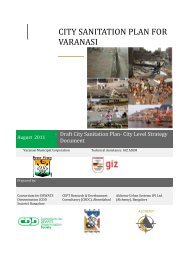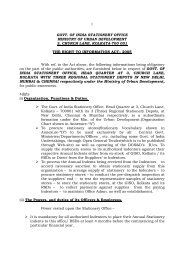CITY SANITATION PLAN - Ministry of Urban Development
CITY SANITATION PLAN - Ministry of Urban Development
CITY SANITATION PLAN - Ministry of Urban Development
You also want an ePaper? Increase the reach of your titles
YUMPU automatically turns print PDFs into web optimized ePapers that Google loves.
<strong>CITY</strong> <strong>SANITATION</strong> <strong>PLAN</strong> BAREILLY<br />
Further considering the sanitation facilities in slum areas, the access to individual toilets is very poor.<br />
There is more access to community toilets than the individual/ private toilets. The different types <strong>of</strong><br />
toilets at individual level in slum areas that are most prevalent are pour flush toilets, Kuddi,<br />
Gaddewali/ soak pit and community toilets. The usage <strong>of</strong> community toilets is very prevalent in slum<br />
areas. The pour flush type <strong>of</strong> toilets at individual level includes the individual toilets provided by ILCS<br />
i.e. about 5826 HH are constructed mainly in slum areas to reduce the open defecation and improve<br />
the sanitary conditions by DUDA.<br />
Further considering the percentage share <strong>of</strong> households/ population having access to household<br />
individual toilets is about 60% <strong>of</strong> the households and these also include the individual pour flush<br />
toilets build by different agencies as mentioned above. These different types <strong>of</strong> households include<br />
pour flush, soak pits, toilets connected to open drain. From the primary survey analysis, focused<br />
group discussions and field visits shows that there are about 5% <strong>of</strong> slum households in addition to<br />
the private/ public individual toilets there are also community toilets in the slum areas – which<br />
majorly cater to the certain share <strong>of</strong> the slum population. There are about 23 community toilets in<br />
Bareilly city – <strong>of</strong> which 21 community toilets are located in slum areas, each catering to about 15 (no.<br />
<strong>of</strong> seats in a community toilet) X 35 (no. <strong>of</strong> persons per seat per day) i.e. about a total population <strong>of</strong><br />
8049 i.e. about 1097 households i.e. about 5% <strong>of</strong> the total slum populations are dependent on<br />
community toilets. This shows that there is about 36.5% <strong>of</strong> the total slum population are using other<br />
options i.e. open defecation is very common i.e. about 11643 slum households i.e. about 89259 <strong>of</strong><br />
population.<br />
slum population total<br />
Total 244170 923138<br />
access to toilets 146502 784732<br />
no toilets 97668 138406<br />
CT 8409 8816<br />
OD 89259 129590<br />
slum HH total<br />
ADMINISTRATIVE STAFF COLLEGE OF INDIA, HYDERABAD Page 76
















